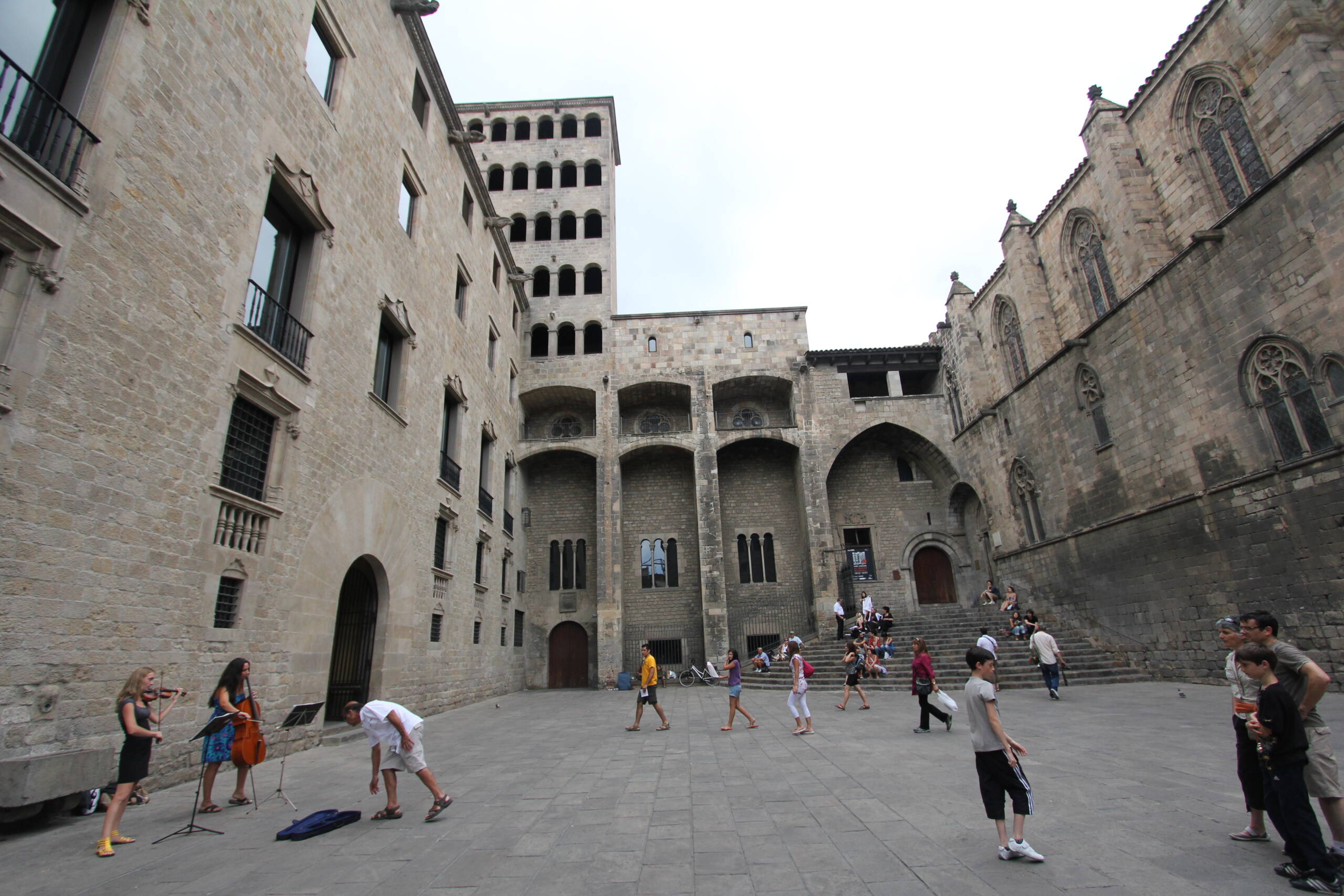There are places in Barcelona that make you pause, places that seem to resist the fast pace of the city and invite you to linger longer than you expected. The Plaça del Rei, the King’s Square in the Gothic Quarter, is one of those rare spaces. Tucked between narrow medieval streets, it suddenly opens into a large stone courtyard surrounded by some of the most imposing buildings of Barcelona’s past. Standing here, you cannot help but feel the presence of centuries of history layered into the walls, arches, and towers, while at the same time watching the everyday life of the city unfold in the most ordinary ways. It is a square where royalty once walked, where nobles debated politics, and where justice was delivered, yet today it belongs equally to tourists, street performers, and locals who sit casually on the steps as if it had always been their living room.

The architecture immediately commands your attention. On one side stands the Palau Reial Major, the former residence of the counts of Barcelona and later the kings of Aragon. Its tall rectangular tower, the Mirador del Rei Martí, rises above the square with rows of evenly cut arched windows stacked in solemn repetition. From here, medieval monarchs once surveyed their city, and one can almost imagine their presence looking down upon the square. The three large arches at the palace base feel monumental, framing the structure with a kind of stern authority. Yet the stone itself, weathered and softened by time, adds a warmth to the severity, showing the resilience of the building rather than its intimidation.
Across the square sits the Royal Chapel of Saint Agatha, its Gothic windows piercing the wall with elegant, narrow forms. These tall stained-glass windows bring verticality to the square, drawing your eyes skyward, in sharp contrast to the weighty horizontality of the palace opposite. Built in the early 14th century, the chapel was meant to balance politics with spirituality, giving the monarchs their own place of worship within steps of their residence. On the other side, to the left, stands the Palau del Lloctinent, or the Lieutenant’s Palace, later used as the Archive of the Crown of Aragon. Every wall here seems to carry stories of power and diplomacy that shaped not just Barcelona but the wider Mediterranean world.
But the square is not a museum; it is alive, constantly rewritten by those who inhabit it each day. In the photograph, you see a violinist and a cellist, playing music that floats upward and bounces gently off the stones. Their sound transforms the atmosphere from solemn to lyrical. Children run across the square with careless joy, their footsteps echoing against centuries-old walls. Small groups of visitors sit on the grand staircase that leads up to the palace, chatting, resting, or just watching the scene unfold as though it were a stage set before them. A man bends over to pick something up from the ground; another group stands in quiet conversation. This blending of the banal and the monumental is the secret charm of Plaça del Rei—life continues as it always does, and the grandeur of history simply watches over it.
Wandering here is a lesson in contrasts. The medieval kings once used this very square for grand ceremonies, receiving foreign ambassadors or celebrating military victories. Today, the ceremony might be a busker’s performance, a casual photograph, or simply a teenager scrolling through their phone on the steps. And yet, both moments belong here. The grandeur of the past does not exclude the ordinariness of the present; instead, they enrich one another. The sense of place is stronger because of this continuity, because Plaça del Rei is not sealed off behind barriers but fully integrated into the daily life of Barcelona.
The best way to experience the square is to simply sit for a while and let the atmosphere seep in. If you come early in the morning, before the crowds arrive, the stillness is profound. The stone glows faintly golden in the first light of the day, and the echoes of your own footsteps feel amplified in the emptiness. Later, as the day unfolds, the square fills with voices in many languages, the music of street performers, and the occasional guided tour explaining centuries of politics in a few sentences. Each hour brings a different personality to the place, and it is worth experiencing it at more than one time of day.
Nearby, the Gothic Quarter unfolds like a labyrinth, every turn revealing another hidden corner. Just steps from the square, you can slip into narrow alleys lined with balconies draped in laundry or flowers, and small tapas bars where the smell of grilled seafood and garlic fills the air. The Barcelona Cathedral is only a few minutes away, its spires visible as you emerge from one winding street to another. Yet Plaça del Rei always draws you back, as if it were the heart of the Gothic Quarter, a gravitational center where history, art, and life converge.
Even if you are not a student of history or architecture, the square offers a feeling that goes beyond dates and names. It offers a sense of belonging to a human story much larger than oneself. Watching children chase pigeons where once knights and kings paraded reminds you that cities are living organisms, constantly reinventing themselves. That is perhaps the greatest beauty of Plaça del Rei—it belongs as much to those who lived centuries ago as to the violinist playing today, and to you, standing quietly in its center, imagining all the lives that have passed through these walls.
Leave a Reply